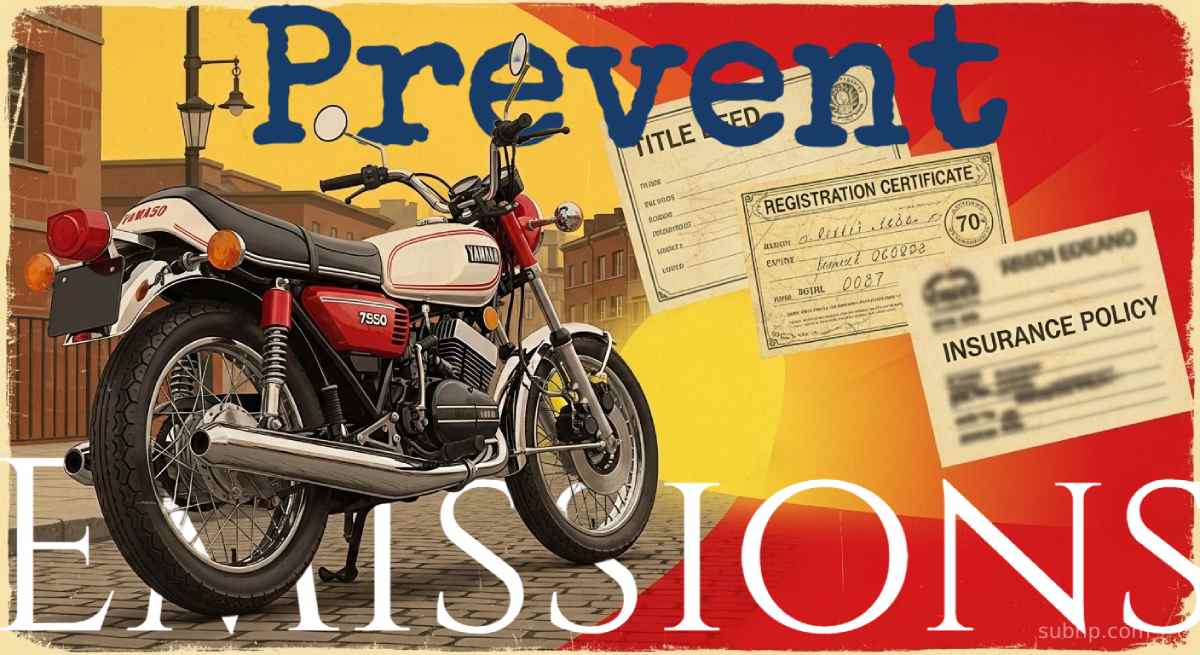- Posted on
- • Classic
Vintage Two-Stroke Emissions Are Harming Brain Development and Heart Health—Here’s How
- Author
-
-

- User
- Torque
- Posts by this author
- Posts by this author
-

Health Implications of Vintage Two-Stroke Emissions, Eliminate Causes
Why Vintage Two-Strokes Are Different (Yeah, We Still Love 'Em)
Let's be honest: those old two-stroke engines – the kind that really sing – work differently. Instead of separate oil, they mix it right into the gas. And their simple port system? It's not perfect. A bit of that fresh fuel-air mix often sneaks straight out the exhaust before it even burns, especially when you're puttering around town or stuck in traffic.
This little quirk has a big downside. Compared to modern four-strokes, vintage two-strokes spit out way more nasty stuff: unburned fuel (hydrocarbons), toxic chemicals like benzene, cancer-linked particles (PAHs), and super-fine soot (UFPs). The worst part? It happens most when you'd think they'd be cleanest – idling or in stop-and-go city driving.
Here's the real kicker, though: research shows that even though there aren't that many two-stroke scooters on the road, they can be the main source of smog-forming gasses and that gritty urban haze. Scientists call this "asymmetric pollution" – meaning a small number of bikes punch way above their weight in messing up the air we breathe. Yeah, they're cool. But yeah, they're dirty.
What's in the plume: the harmful cocktail
<
h3>Ultrafine Particles (UFPs) (<100 nm)
Penetrate deep into the lungs and can enter the bloodstream; long-term exposure is linked to cardiovascular and lung cancer mortality. UFPs aren't yet regulated by mass-based PM rules, but evidence has strengthened.
Fine PM (PM2.5)
Strongly associated with heart, stroke, and respiratory disease; both short- and long-term exposure increase morbidity and mortality.
Benzene
A Group 1 human carcinogen, linked to leukemia (AML) and other hematologic cancers. Two-stroke exhaust and refueling vapors add to ambient benzene load.
PAHs
Mutagenic/carcinogenic compounds formed in incomplete combustion; abundant in oil-rich two-stroke exhaust and implicated in cardiopulmonary risks.
What the studies say about two-strokes and health exposure
Dominant local source: Controlled experiments measured orders-of-magnitude higher VOC and organic aerosol formation from two-stroke scooters than from modern vehicle classes—explaining strong roadside exposure despite low fuel share.
Human proximity matters: Riders, pillions, nearby cyclists, and pedestrians get peak exposure at idle/acceleration where unburned mix and oil droplets spike. This is consistent with UFP science showing the smallest particles surge near tailpipes and traffic lights.
Occupational analogs: Studies using benzene as a marker of fuel exposure show higher personal exposure around carbureted two-strokes compared with four-strokes/diesel in similar tasks. While contexts differ (e.g., marine), the mechanism—unburned fuel and oil—is shared.
Health implications you should actually care about
Short-term: throat/eye irritation, asthma exacerbations, reduced lung function on high-exposure days. UFP/PM2.5 peaks near vintage meets or congested corridors can trigger symptoms in sensitive groups.
Long-term: elevated risk of ischemic heart disease, stroke, COPD, and lung cancer from chronic PM exposure; hematologic cancers specifically tied to benzene exposure.
Pros & cons of keeping vintage two-strokes on the road
Pros (why enthusiasts love them):
Lightweight, simple mechanics, distinctive powerband and sound; cultural heritage.
Cons (health & air quality):
Disproportionately high VOCs/UFPs/PAHs per km vs. four-strokes; strongest at idle and low load.
Carcinogenic species present (benzene, certain PAHs).
Neighborhood exposure where people walk, cycle, and wait—schools and markets see the worst of stop-and-go plumes.
Practical risk-reduction for riders and events (without killing the vibe)
Maintain perfectly: fresh rings, seals, and reeds; correct timing/jetting; clean exhaust; use the correct 2T oil ratio—over-oiling spikes hydrocarbons and smoke. (This reduces—not eliminates—toxics.)
Warm start & avoid long idling: minimize idle-rich operation where VOCs/UFPs peak.
Route and timing: plan rides away from school hours and crowded pedestrian zones; keep stationary display time short. (Public-health rationale: cut proximity exposure.)
Mix the fleet: for club runs, alternate with cleaner four-strokes or EV chase/support bikes to reduce the group's average plume.
Ventilation at workshops/garages: use exhaust extraction; limit indoor cold-starts to reduce benzene/UFP buildup.
Fun facts (that aren't so fun)
In smog-chamber tests, aging two-stroke exhaust forms secondary organic aerosol efficiently—meaning yesterday's ride can add to today's haze after chemical transformation in sunlight.
UFPs aren't directly regulated by current PM mass standards, even though they drive many near-road health effects—one reason vintage two-stroke hotspots can be underestimated by standard monitors.
FAQs
Q: If my vintage two-stroke passes a local smoke/CO test, is it "healthy"?
A: Not necessarily. Many tests don't capture VOCs, PAHs, or UFP spikes under real driving—especially idle/acceleration where two-strokes misbehave.
Q: Do premium or synthetic 2T oils make emissions safe?
A: Better oils can reduce deposits and visible smoke, but they don't fix unburned fuel/oil escape intrinsic to port-scavenged designs.
Q: What's the single biggest health-protective change?
A: Reduce proximity exposure: avoid idling in crowds, improve ventilation, and—where possible—use a cleaner ride for daily trips, saving the vintage bike for short, well-planned outings. The health literature consistently links lower PM/UFP exposure with better outcomes.
Bottom Line
Let's be real: vintage two-strokes aren't just machines—they're alive. That raw, snarling heartbeat under your leg? The way they beg you to twist the throttle and feel every RPM? That's motorcycle soul—unfiltered, unapologetic, and woven into our history. Yeah, they're dirtier than modern bikes (blame that iconic putt-putt for spitting out soot, benzene, and sneaky smog-makers). But here's the beautiful part: we're the kind of riders who fix what we love.
So let's honor these legends the right way:
✓ Tune like a proud owner (a crisp, clean two-stroke sings—and pollutes less)
✓ Idle? Nah, we rest (shut it down at lights—your bike and the air thank you)
✓ Ride the scenic route (skip traffic jams; chase open roads where your two-stroke thrives)
✓ Save 'em for joyrides (commute on modern bikes, but let your vintage rip on weekends)
This is two-stroke love in action.
Every time you nail that jetting so your engine sings, or chase twisties instead of traffic jams—you're not just riding. You're honoring the legacy and the land. That crisp ba-ba-bap echoing through the canyons? That's the sound of two-stroke magic thriving—cleaner, louder, and prouder than ever. Real riders don't just keep legends alive… we make 'em better.
